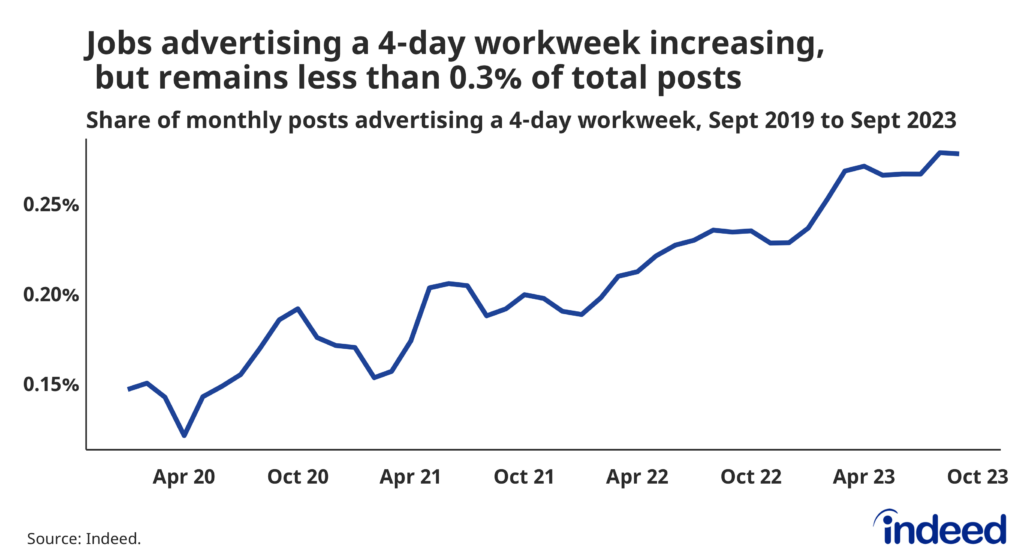Key Points:
- Jobs advertising a 4-day workweek accounted for 0.3% of total Indeed job postings for September.
- Sectors with the highest share of 4-day advertisements were concentrated in in-person jobs including dentistry and veterinary services.
- Manufacturing is also one of the top sectors advertising a 4-day workweek, amid demands for a shorter workweek from the striking auto workers union.
Our monthly Labor Market Update looks at an important labor market trend through the lens of Indeed data. A more comprehensive view of the US labor market can be found in our US Labor Market Overview chartbook. Data from our Job Postings Index — which stands 27.8% above its pre-pandemic baseline as of October 20 — and the Indeed Wage Tracker, are regularly updated and can be downloaded on our data portal, and GitHub.
While it remains very small overall, the share of job postings on Indeed advertising a 4-day workweek has roughly tripled in four years, rising from just 0.1% of postings in September 2019 to almost 0.3% in September 2023. It may be tempting to attribute the rise to changing attitudes in more remote-friendly industries like tech. But it’s actually heavily in-person sectors — including manufacturing, where many striking workers are currently demanding shorter work weeks — that make up the bulk of advertisements.
4-day workweek advertisements remain low

The overall share of postings advertising a 4-day workweek may be low, but it does continue to climb. Mentions of 4-day work weeks are growing fastest, by far, in the veterinary services sector, with the share of postings noting the perk growing by 1.39 percentage points from September 2019 to September 2023. Dentistry was the next-fastest-growing sector over that time, up 0.9 percentage points, followed by growth of 0.37 percentage points for industrial engineering.

Manufacturing & Production among top sectors
Dentistry roles have the largest current share of 4-day workweek postings at 2.7% in September, followed closely by veterinary jobs at just over 2%. Physicians & surgeons (1%), production & manufacturing (0.7%), and driving roles (0.7%) round out the list of the five sectors with the highest share of jobs mentioning a 4-day work week. Tech sectors including software and IT both come in at just 0.2% and did not crack the top five.

Jobs in manufacturing and production advertising a 4-day workweek have increased by 40% since September 2019, but only an increase in level terms from just 0.5% of manufacturing jobs to a still-paltry 0.7%. While it’s difficult to tell if four-day work week opportunities for manufacturing workers will continue to grow, it is currently a topic of lively discussion. Leaders of the UAW, which represents roughly 400,000 unionized North American manufacturing workers, were demanding a 4-day workweek as part of their contract negotiations and strike against the nation’s Big Three automakers.
Conclusion
A 4-day workweek may be gaining popularity, but it has a long way to go before becoming the norm. While the share has increased over the years, the total number of jobs advertising a 4-day workweek account for less than 0.3% of total postings, concentrated in just a few sectors. But even among those top advertising sectors, 4-day workweek positions account for at most 2.7% of posts.
A 4-day workweek is more commonly advertised in sectors that are unlikely to benefit from other competitive perks, including remote/hybrid offices — dentists, doctors, vets, factory workers, and drivers simply can’t do their work remotely. Time will tell if this remains a rare benefit offered for some in-person roles in order to stay competitive, or becomes an expectation for job seekers and/or a more common demand in union negotiations. But for office workers in particular, a standardized 4-day workweek is a long way off.
Methodology
We define 4-day workweek postings as those that include one or more variations of keywords related to “4-day workweek.” Definitions change slightly from year to year, so previous 4-day workweek analyses are not directly comparable.



